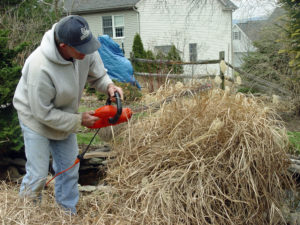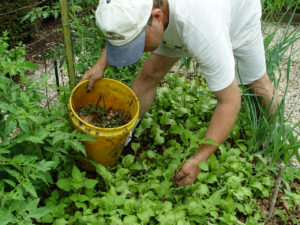The Best – and Worst – Times to Do Things Around the Yard
March 1st, 2022
Some gardening jobs can be done most any time.

Cutting the ornamental grasses with a power trimmer.
But others need to happen at certain times if you don’t want to, say, freeze your tomatoes by planting them too soon or cut off your hydrangea flowers by pruning them at the wrong time.
As we approach another new gardening season, it’ll help to know when to do what. Here’s a look at the best times and worst times to do a dozen key tasks in Pennsylvania yards:
Pruning
Best time: For spring-flowering trees and shrubs, right after they’re done blooming. For summer-flowering trees and shrubs, first thing in early spring. For shade trees, late winter when leafless. For evergreens, early spring through mid-summer.
Worst time: Fall. Everything should be left alone to prepare for winter’s cold then. Plus, you’ll cut off the already-formed flower buds for next year by pruning spring-blooming shrubs and trees in fall.
Fertilizing
Best time: Spring and early fall – right before periods of good growth.
Worst time: Any time the ground is frozen and during hot, dry weather in summer.
Planting
Best time: For woody plants and perennials, end of March through May and between Labor Day and end of October in fall. For frost-sensitive annuals and vegetables, mid-May through early summer.
Worst time: Winter and during a heat wave in summer. For borderline-hardy species, spring is a better time to plant instead of fall (more time for the roots to take hold).
Digging soil
Best time: Spring – after the soil has dried. Or any time in summer or fall.
Worst time: Any time the soil is wet or frozen.
Grass-seeding
Best time: End of August through end of October. Second best is early spring.
Worst time: Late fall, winter and during a hot, dry spell in summer.

Mid-spring is a good time to mulch.
Mulching
Best time: Mid-spring after the ground has had a chance to dry out and warm up from winter. Summer through fall is also fine.
Worst time: End of winter through early spring as plants are coming out of dormancy and soil is still cold and wet. (Mulch impedes warming and drying.)
Watering
Best time: Early morning and early evening when evaporation loss is lower and leaves have a chance to dry before dark.
Worst time: At night or just before dark (leaves will be wet all night) or midday (high evaporation loss).
Mowing
Best time: Late morning, afternoon or evening when grass and soil aren’t wet.
Worst time: When soil is soggy and grass is wet or heading into a hot, dry spell in summer when taller grass will keep evaporative moisture loss to a minimum.

Weed when wet, hoe when dry.
Weeding
Best time: After a rain and when weeds are little.
Worst time: After weeds have gone to seed and begun to drop it to fuel a future outbreak.
Staking
Best time: When plants are young and small. For tall, flop-prone annuals, as soon as they’re planted.
Worst time: After plants have already flopped. It’s hard to corral them then without creating an awkward straitjacket look.
Disease-controlling
Best time: At the first sign of a disease outbreak that requires treatment to avoid plant death or serious disfigurement.
Worst time: After an infection has gone full bore. Damage can’t be undone, and fungicides don’t work well after the early stages of an infection.
Dividing perennials
Best time: Early to mid-spring for plants that bloom in fall (mums, sedum and aster, for example) and in early fall for spring bloomers (salvia, dianthus, daylilies, etc.)
Worst time: In the middle of a summer heat wave, especially at midday. Late fall is second worse when divided plants won’t have enough time to root before the ground freezes.
Read George’s gardening to-do lists for each month of the year
See how to get an autographed copy of George’s “Pennsylvania Month-by-Month Gardening” book







